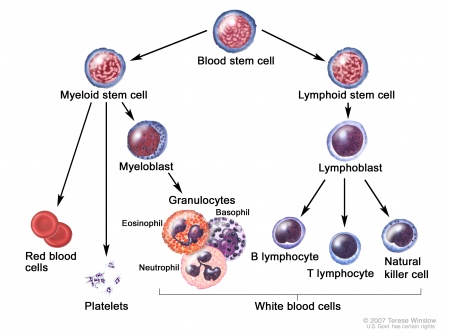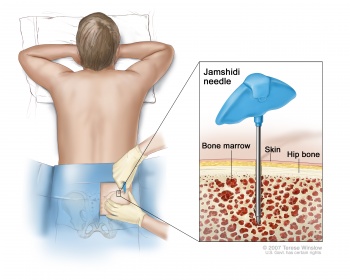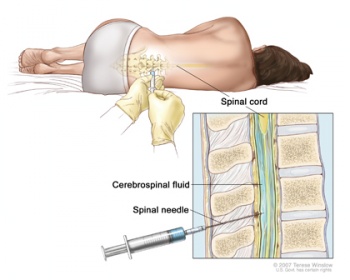Acute Lymphoblastic Leukemia: Difference between revisions
Erin Foster (talk | contribs) No edit summary |
Erin Foster (talk | contribs) No edit summary |
||
| Line 13: | Line 13: | ||
[Photo courtesy of Medimanage. Available at [http://www.medimanage.com/Images/leukemia_250x251.jpg http://www.medimanage.com/Images/leukemia_250x251.jpg.]] | [Photo courtesy of Medimanage. Available at [http://www.medimanage.com/Images/leukemia_250x251.jpg http://www.medimanage.com/Images/leukemia_250x251.jpg.]] | ||
== Definition/Description<br> | == Definition/Description<br> == | ||
Acute lymphoblastic leukemia (ALL) is a cancer of the blood and bone marrow. Bone marrow is spongy tissue that fills the cavity of the long bones consisting of fat, red blood cells, and white blood cells. ALL affects the immature white blood cells. This type of cancer is classified by one of two subtypes. | Acute lymphoblastic leukemia (ALL) is a cancer of the blood and bone marrow. Bone marrow is spongy tissue that fills the cavity of the long bones consisting of fat, red blood cells, and white blood cells. ALL affects the immature white blood cells. This type of cancer is classified by one of two subtypes. | ||
[[Image:Cells.jpg|center|450x350px]] | [[Image:Cells.jpg|center|450x350px]] [Photo courtesy of The University of Chicago Medical Center. Available at [http://www.uchospitals.edu/online-library/content=CDR257989 http://www.uchospitals.edu/online-library/content=CDR257989]] | ||
The two subtypes include: | The two subtypes include: | ||
Revision as of 23:42, 3 April 2011
Original Editors - Erin Foster from Bellarmine University's Pathophysiology of Complex Patient Problems project.
Lead Editors - Your name will be added here if you are a lead editor on this page. Read more.
[edit | edit source]
[edit | edit source]
[Photo courtesy of Medimanage. Available at http://www.medimanage.com/Images/leukemia_250x251.jpg.]
Definition/Description
[edit | edit source]
Acute lymphoblastic leukemia (ALL) is a cancer of the blood and bone marrow. Bone marrow is spongy tissue that fills the cavity of the long bones consisting of fat, red blood cells, and white blood cells. ALL affects the immature white blood cells. This type of cancer is classified by one of two subtypes.
[Photo courtesy of The University of Chicago Medical Center. Available at http://www.uchospitals.edu/online-library/content=CDR257989]
The two subtypes include:
B-cell- produce antibodies to fight infections.
- Common ALL (50% of cases)
- Early Pre-B ALL (10% of cases)
- Pre-B ALL (10% of cases)
- Mature B-cell ALL (4% of cases)
T-cell- assist B-cells in producing antibodies to fight infections.
- Pre-T ALL (5-10% of cases)
- Mature T-cell (15-20% of cases)
Prognostic factors include:
- Age
- White blood cell count
- ALL subtype
- Response to treatment
Prevalence
[edit | edit source]
ALL is the most common cancer occurring in children today and can occur in some adult cases. Children are at the highest risk between 2 and 4 years of age. This risk decreases from age 4 to mid-20s, increasing again after age 50. The average person has a 1 in 1,000 chance of getting ALL. The American Cancer Society estimated the following statistics for 2010:
- Approximately 43,050 new cases of all types of leukemia.
- Approximately 5,330 new cases of acute lymphoblastic leukemia (1 out of 3 were adult cases).
- Approximately 1,420 deaths from ALL (3 out of 4 were adult cases).
Characteristics/Clinical Presentation[edit | edit source]
Most signs and symptoms of ALL mimic those of the flu. However, with ALL these signs and symptoms will not improve. Signs and symptoms include:
- Weight loss
- Bleeding from the gums
- Nosebleeds
- Pale skin
- Shortness of breath
- Fever
- Frequent infections
- Weakness
- Fatigue
- Swollen lymph nodes (neck, underarm, groin, stomach)
Associated Co-morbidities[edit | edit source]
The following co-morbidities are linked to ALL:
- Anemia- a deficiency of red blood cells.
- Diabetes- disorder characterized by defects in the body's ability to produce or use insulin resulting in high blood glucose levels.
- Lupus- a chronic autoimmune disease that effects many systems in the body.
- Rheumatoid Arthritis- a chronic systemic inflammatory disorder.
- Multiple Sclerosis- an autoimmune disease that attacks the central nervous system.
Medications[edit | edit source]
Medications involved with ALL include:
- Gleevec
- Adriamycin
- Purinethol
- Sprycel
- Trexall
- Oncaspar
- Arranon
- Clolar
- Vumon
Diagnostic Tests/Lab Tests/Lab Values[edit | edit source]
Diagnostic tests and results for ALL include:
- Blood test- These tests reveal increased number of white blood cells, decreased number of red blood cells and platelets. A blood test may also reveal blast cells. Blast cells are immature blood cells in bone marrow.
Picture fromwebsite[edit | edit source]
- Bone marrow test- A needle is used to remove a sample of bone marrow from the hipbone to look for cancerous cells. Through this process, doctors can determine if the cells originated from the B lymphocytes or T lymphocytes according to certain changes in the cancer cells.
Picture from website[edit | edit source]
- Lumbar puncture or spinal tap- A sample of spinal fluid is collected to determine if the cancerous cells have spread.
Picture fromwebsite[edit | edit source]
- Imaging- X-ray and computerized tomography (CT) scan can help determine if the cancer has spread to other parts of the body.
Etiology/Causes[edit | edit source]
The exact causes are unknown. However, there are some risk factors thought to be linked to ALL. These risk factors include:
- Chemical
- Radiation exposure or past chemotherapy or radiation treatments
- Viral infection
- Certain inherited disorders
o Down syndrome
o Klinefelter syndrome
o Fanconi anemia
o Bloom syndrome
o Ataxia-telangiectasia
o Neurofibromatosis
Systemic Involvement[edit | edit source]
Medical Management (current best evidence)[edit | edit source]
Treatment for ALL can span from 2 ½ to 3 ½ years depending on each individual situation. General treatment for ALL is broken down into the following 4 phases:
- Induction therapy- The purpose of this phase is to kill most of the cancer cells in the blood and bone marrow.
- Consolidation therapy/ Post- remission therapy- During this phase, the goal is to destroy any remaining leukemia cells in the central nervous system.
- Maintenance therapy- This low dose treatment is given to prevent cancer cell re-growth.
- Preventive treatment to the spinal cord- Some cancer cells in the central nervous system can not be destroyed by chemotherapy drugs given by oral or intravenous means. During this phase, chemotherapy drugs are injected directly into the spinal cord fluid.
During these 4 phases the specific types of treatments include:
- Chemotherapy- Chemotherapy is normally used in the induction therapy stage to kill the cancer cells. This drug can also be used in the consolidation and maintenance phases.
- Targeted drug therapy- These drugs attack specific abnormalities that cause the cancer cell growth.
- Radiation therapy- This treatment uses high-powered beams to destroy cancer cells. This is typically used when the cancer has spread to the central nervous system.
- Stem cell transplant- This transplant may be used for patients at risk or currently going through a relapse. This procedure replaces cancer bone marrow through chemotherapy or radiation with healthy bone marrow from a compatible donor allowing re-establishment of healthy stem cells.
Physical Therapy Management (current best evidence)[edit | edit source]
add text here
Alternative/Holistic Management (current best evidence)[edit | edit source]
No alternative treatments have been found to cure ALL, but some alternative treatments have been used to ease signs and symptoms. These alternative treatments include:
- Medications
- Acupuncture
- Massage
- Aromatherapy
- Relaxation exercises
Differential Diagnosis[edit | edit source]
The following are possible differential diagnosis for ALL:
- Acute myelocytic leukemia
- Acute anemia
- Juvenile Rheumatoid Arthritis
- Leukocytosis
- Mononucleosis and Epstein-Barr virus
- Neuroblastoma
- Non-Hodgkin Lymphoma
- Osteomyelitis
- Parvovirus B19 infection
- Rhabdomyosarcoma
Case Reports/ Case Studies[edit | edit source]
add links to case studies here (case studies should be added on new pages using the case study template)
Resources
[edit | edit source]
add appropriate resources here
Recent Related Research (from Pubmed)[edit | edit source]
see tutorial on Adding PubMed Feed
Extension:RSS -- Error: Not a valid URL: Feed goes here!!|charset=UTF-8|short|max=10
References[edit | edit source]
see adding references tutorial.










